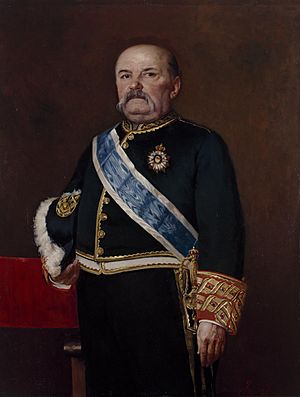Manuel Becerra Bermúdez facts for kids
Quick facts for kids
Manuel Becerra
|
|
|---|---|

Portrait by Francisco Jover y Casanova
|
|
| Personal details | |
| Born | 20 October 1820 Santa María del Otero, Castro de Rey, Spain |
| Died | 19 December 1896 Madrid, Spain |
| Political party | Democratic Party Liberal Fusionist Party Dynastic Left |
| Occupation | Politician, math teacher, revolutionary, academic |
| Signature | |
Manuel Becerra Bermúdez (born October 20, 1820 – died December 19, 1896) was an important Spanish politician, a skilled mathematician, and a leader in big changes. He started as someone who believed in a republic (a country without a king or queen). Later, he supported having a king or queen.
Manuel Becerra served as a minister in the Spanish government. He was in charge of the Overseas department (dealing with colonies) and the Development department (working on public projects). He held these roles during a time of big changes in Spain called the Sexenio Democrático. He also served as Overseas minister two more times later on.
Contents
Manuel Becerra's Early Life and Big Ideas
Manuel Becerra was born in a place called Santa María del Otero, in Castro de Rei, Spain. This was on October 20, 1820. His father was a math teacher. Manuel himself became very good at math, physics, and astronomy. He even started a famous math school in Madrid.
Fighting for Change in Spain
When he was young, Manuel Becerra strongly believed in republicanism. This meant he wanted Spain to be a republic, not a monarchy. He took part in the 1848 Spanish Revolution, which was a time of protests and fighting for more freedom.
In 1849, he helped create the Democratic Party. He also joined in the 1854 revolts in Madrid. He fought in the streets and was arrested and put in jail.
Later, in 1856, he fought again to protect people's freedoms. He was even sentenced to death for his part in another uprising in 1866. But he managed to escape and had to leave Spain.
Working for a New Government
While in exile, Manuel Becerra helped plan a big change for Spain. He was one of the main people behind the Pact of Ostend in 1866. This agreement aimed to remove Queen Isabella II from power. It also called for new elections where all men could vote.
A Time of Change: The Democratic Six Years
After the Glorious Revolution in 1868, Queen Isabella II was removed. Manuel Becerra became part of the new revolutionary government. He was one of the leaders of a group called the cimbrios. These were democrats who now supported having a king, but with more democratic rules.
Helping Overseas Lands
In July 1869, Manuel Becerra became the Minister of Overseas. This job meant he was in charge of Spain's colonies. He had a very important goal: to end slavery in Puerto Rico. He tried to pass laws to do this in 1869.
However, many people in the government and parliament did not agree with him. They wanted slavery to continue. After a lot of strong opposition, Manuel Becerra had to resign in March 1870.
Minister of Development
In December 1872, Manuel Becerra became the Minister of Development. This role involved working on public projects and improving the country. On February 11, 1873, Spain became the First Republic. Manuel Becerra was confirmed in his role as Minister of Development. He left this job later that same month.
Later Years and Important Roles
After the monarchy was brought back to Spain, Manuel Becerra joined the Liberal Fusionist Party. This party was led by Práxedes Mateo Sagasta. In 1881, he left this party to start a new group called the Dynastic Left.
Manuel Becerra was also a Freemason, which is part of a private social group. He became a very high-ranking leader in a Spanish Freemason group in 1884.
In 1885, he was chosen to join the Spanish Royal Academy of Sciences. This is a very respected group of scientists. He officially joined in 1886. He gave a speech about how mathematics has changed over time. He also talked about how Arab civilization helped math grow.
Manuel Becerra returned to his role as Minister of Overseas two more times. He served from December 1888 to January 1890, and again from March 1894 to November 1894. These were both under the leadership of Sagasta.
Manuel Becerra passed away on December 19, 1896, in Madrid. He was 76 years old.
Images for kids
See also
 In Spanish: Manuel Becerra y Bermúdez para niños
In Spanish: Manuel Becerra y Bermúdez para niños


